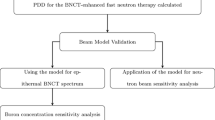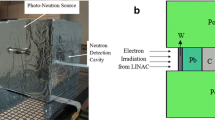Abstract
An accelerator-based Boron Neutron Capture Therapy (AB-BNCT) experimental facility called D-BNCT01 has been recently completed and is currently able to generate a high-intensity neutron beam for BNCT-related research. In this study, we perform several experiments involving water phantoms to validate the Monte Carlo simulation results and analyze the neutron beam characteristics. According to our measurements, D-BNCT01 can generate a neutron flux about 1.2 × 108 n/cm2/s at the beam port using a 5 kW proton beam. Our results also show that the thermal neutron flux depth distribution inside the water phantom is in good agreement with simulations. We conclude that D-BNCT01 may be effectively employed for BNCT research.









Similar content being viewed by others
References
M. Wang, Y. Tong, Q. Luo et al., Study of ATP borate ester effects on cell sensitization to radiation emitted by a nuclear reactor. Nucl. Sci. Tech. 31, 2 (2020). https://doi.org/10.1007/s41365-019-0713-0
R.F. Barth, J.A. Coderre, M.G.H. Vicente et al., Boron neutron capture therapy of cancer: Current status and future prospects. Clin. Cancer Res. 11, 3987 (2005). https://doi.org/10.1158/1078-0432.Ccr-05-0035
H. Hatanaka, Clinical results of boron neutron capture therapy. Basic Life Sci. 54, 15 (1990)
D.A. Allen, T.D. Beynon, S. Green, Design for an accelerator-based orthogonal epithermal neutron beam for boron neutron capture therapy. Med. Phys. 26, 71 (1999). https://doi.org/10.1118/1.598479
D. Cartelli, M.E. Capoulat, T.J. Bergueiro et al., Present status of accelerator-based BNCT: Focus on developments in Argentina. Appl. Radiat. Isot. 106, 18 (2015). https://doi.org/10.1016/j.apradiso.2015.07.031
C. Ceballos, J. Esposito, S. Agosteo et al., Towards the final BSA modeling for the accelerator-driven BNCT facility at INFN LNL. Appl. Radiat. Isot. 69, 1660 (2011). https://doi.org/10.1016/j.apradiso.2011.01.032
T.A. Bykov, D.A. Kasatov, A.M. Koshkarev et al., A multichannel neutron flux monitoring system for a boron neutron capture therapy facility. J. Instrum. 14, P12002 (2019). https://doi.org/10.1088/1748-0221/14/12/p12002
M. Kim, B.H. Hong, I. Cho et al., Design of a scintillator-based prompt gamma camera for boron-neutron capture therapy: Comparison of SrI2 and GAGG using Monte-Carlo simulation. Nucl. Eng. Technol. 53, 626 (2021). https://doi.org/10.1016/j.net.2020.07.010
H. Kumada, K. Takada, S. Tanaka et al., Evaluation of the characteristics of the neutron beam of a linac-based neutron source for boron neutron capture therapy. Appl. Radiat. Isot. 165, 109246 (2020). https://doi.org/10.1016/j.apradiso.2020.109246
P.E. Tsai, Y.H. Liu, H.M. Liu et al., Characterization of a BNCT beam using neutron activation and indirect neutron radiography. Radiat. Meas. 45, 1167 (2010). https://doi.org/10.1016/j.radmeas.2010.07.008
A. Ishikawa, A. Yamazaki, K. Watanabe et al., A comparison between simulation and experimental results for depth profile of Li-6 reaction rate in a water phantom of BNCT using a small Li-6-based scintillator neutron detector with an optical fiber. Radiat. Meas. 133, 106270 (2020). https://doi.org/10.1016/j.radmeas.2020.106270
L.S. Waters, G.W. McKinney, J.W. Durkee et al., The MCNPX Monte Carol radiation transport code, Paper presented at the Hadronic Shower Simulation Workshop (Batavia, IL, 6–8 Sep. 2007)
H. Liskien, A. Paulsen, Neutron production cross sections and energies for the reactions 7Li (p, n) 7Be and 7Li (p, n) 7Be∗. At. Data Nucl. Data Tables. 15, 57 (1975). https://doi.org/10.1016/0092-640X(75)90004-2
G.F. Knoll, Radiation detection and measurement, 4th edn. (John Wiley and Sons Inc., New Jersey, 2010), pp. 767–774
M.B. Chadwick, M. Herman, P. Oblozinsky et al., ENDF/B-VII.1 nuclear data for science and technology: cross sections, covariances, fission product yields and decay data. Nucl. Data Sheets 112, 2887 (2011). https://doi.org/10.1016/j.nds.2011.11.002
A. Trkov, P.J. Griffin, S.P. Simakov et al., IRDFF-II: A new neutron metrology library. Nucl. Data Sheets 163, 1 (2020). https://doi.org/10.1016/j.nds.2019.12.001
Y.H. Liu, C.K. Huang, P.E. Tsai et al., BNCT epithermal neutron beam mapping by using indirect neutron radiography. Nucl. Technol. 168, 354 (2009). https://doi.org/10.13182/nt09-a9208
F. Acerbi, S. Gundacker, Understanding and simulating SiPMs. Nucl. Instrum. Methods Phys. Res. A 926, 16 (2019). https://doi.org/10.1016/j.nima.2018.11.118
P.P. Calo, F. Ciciriello, S. Petrignani et al., SiPM readout electronics. Nucl. Instrum. Methods Phys. Res. A 926, 57 (2019). https://doi.org/10.1016/j.nima.2018.09.030
S. Nakamura, H. Igaki, M. Ito et al., Neutron flux evaluation model provided in the accelerator-based boron neutron capture therapy system employing a solid-state lithium target. Sci. Rep. 11, 8090 (2021). https://doi.org/10.1038/s41598-021-87627-8
S. Nakamura, H. Igaki, M. Ito et al., Characterization of the relationship between neutron production and thermal load on a target material in an accelerator-based boron neutron capture therapy system employing a solid-state Li target. PLoS ONE 14, e0225587 (2019). https://doi.org/10.1371/journal.pone.0225587
Author information
Authors and Affiliations
Contributions
All authors contributed to the study conception and design. Material preparation, data collection and analysis were performed by Jun-Yang Chen, Jian-Fei Tong, Zhi-Liang Hu, Xue-Fen Han, Bin Tang, Qian Yu, Rui-Qiang Zhang, Chong-Guang Zhao, Jun Xu, Shi-Nian Fu, Bin Zhou and Tian-Jiao Liang. The first draft of the manuscript was written by Jun-Yang Chen and all authors commented on previous versions of the manuscript. All authors read and approved the final manuscript.
Corresponding authors
Additional information
This work was supported by the Program for Guangdong Introducing Innovative and Entrepreneurial Teams (No. 2017ZT07S225), the Institute of High Energy Physics Xie-Jialin Foundation (No. Y95461F), and the National Natural Science Foundation of China (No. U1932219).
Rights and permissions
About this article
Cite this article
Chen, JY., Tong, JF., Hu, ZL. et al. Evaluation of neutron beam characteristics for D-BNCT01 facility. NUCL SCI TECH 33, 12 (2022). https://doi.org/10.1007/s41365-022-00996-1
Received:
Revised:
Accepted:
Published:
DOI: https://doi.org/10.1007/s41365-022-00996-1




